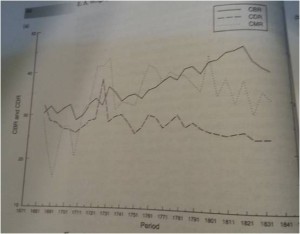Demography and the Industrial Revolution
What were the causes of the distinctive characteristics of English fertility behaviour during the Industrial Revolution? (b) How did the fertility rate interact with economic growth during this period?
 Before the causes of fertility behaviour are explored, we need to first look at what these characteristics were in the first place. From the graph to the left1 we can see that the crude birth rate (which is defined as the number of live births per 1000 people) starts off at about 30 births per 1000 people in 1680 but increases to about 44 births per 1000 by 1820. This is a significant increase, especially as Malthus believed that the maximum biological rate of fertility can only be about 50 per 1000 people – so the fertility rate was approaching the maximum in 1820. [...]
Before the causes of fertility behaviour are explored, we need to first look at what these characteristics were in the first place. From the graph to the left1 we can see that the crude birth rate (which is defined as the number of live births per 1000 people) starts off at about 30 births per 1000 people in 1680 but increases to about 44 births per 1000 by 1820. This is a significant increase, especially as Malthus believed that the maximum biological rate of fertility can only be about 50 per 1000 people – so the fertility rate was approaching the maximum in 1820. [...]